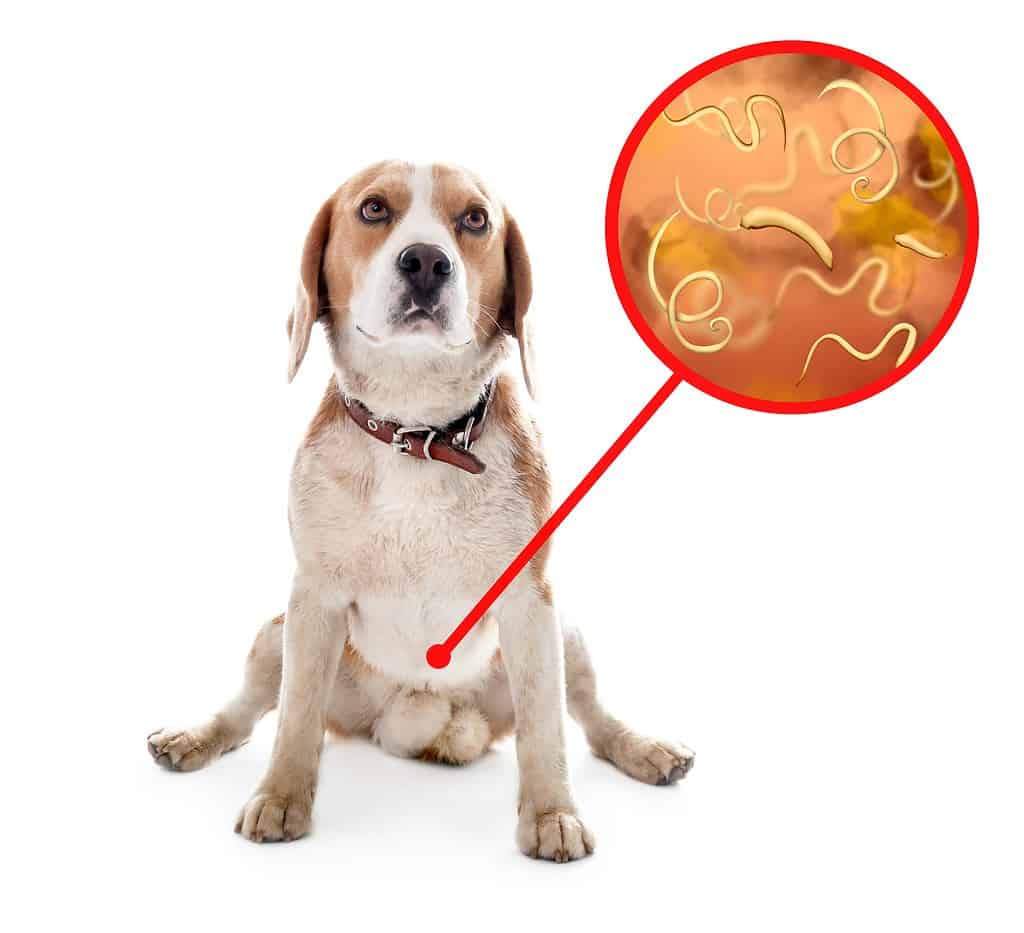Dealing with pests is one of the least fun parts of pet ownership! If your dog isn’t on a parasite preventative, you might come across fleas, tapeworms, and other icky parasites.
Tapeworms are worms that live in your dog’s digestive system. They typically get there when a dog eats a larvae-infested flea.
Controlling fleas is the number one way to get rid of tapeworms in dogs for good. Dogs with tapeworms should also be given a prescription medication to kill the tapeworms in their system.
There are no effective home remedies for tapeworms. It’s important to see a veterinarian when you notice signs of tapeworms to get proper treatment for your pup.
In this article, we’ll talk more about how to get rid of tapeworms in dogs, what your vet is likely to prescribe, and more.
Tapeworms in Dogs: What are Tapeworms?

Dogs and cats don’t typically show signs of illness with tapeworm infection unless the infestation is severe or they are young.
©New Africa/Shutterstock.com
Tapeworms are worms that grow inside an animal’s digestive system. Each worm is made of several segments, or proglottids, that can break off of its body as they grow.
Proglottids are about the size of a grain of rice, and they’re often the only symptom of tapeworms in dogs. You may see them moving around in your dog’s poop or around their anus.
They also carry eggs so that the tapeworms can continue reproducing.
Dried proglottids are hard and yellow.
Other symptoms may include your dog scooting its butt across the floor, weight loss, and vomiting. Vomit sometimes contains whole worms, which can be up to 28 inches long.
Dogs and cats don’t typically show signs of illness with tapeworm infection unless the infestation is severe or they are young.
Severe infections or those in puppies might cause a lack of growth, develop anemia, and intestinal blockages due to tapeworm.
Your dog also has a chance of liver damage, brain cysts, or death. So while tapeworms are very common and easy to treat, it’s important to get that treatment before the infestation worsens.
2 Ways to Get Rid of Tapeworms in Dogs

Your dog needs to see a veterinarian if they’re going to receive the right treatment.
©SeventyFour/Shutterstock.com
Getting rid of tapeworms starts with bringing your dog to the veterinarian. They can prescribe the medications needed to get rid of both the tapeworms and the fleas, which will both kill the current infestation and prevent it from happening again.
Tapeworms in Dogs: Parasiticide
A parasiticide called Praziquantel is used to treat tapeworms. It comes in two forms: as an oral medication and an injection. Multiple doses might be needed to kill all of the tapeworms, their larvae, and their eggs.
Praziquantel is very effective against tapeworm and has no known side effects, so it’s very safe!
This is a prescription medication, so your dog needs to see a veterinarian if they’re going to receive the right treatment.
Your vet can also rule out other conditions and speak with you about how to prevent tapeworms in the future.
After your dog has been given Praziquantel, you’re unlikely to see whole, dead worms in their stool. Instead, the medication causes your dog’s body to digest the worms.
Treat for Fleas

The best
way to fight fleas is to keep your dog
on a parasite prevention medication year-round.
©Reddogs/Shutterstock.com
According to the CDC, dogs get tapeworms by eating fleas that have been infected with their larvae. Inside the dog, the larvae then grow into an adult tapeworm.
Dogs may consume fleas while grooming or itching themselves. If the fleas stick around, chances are that your dog will develop tapeworm again.
The best way to fight fleas is to keep your dog on a parasite prevention medication year-round. There are various flea medications for dogs, including topical, injectable, and oral medications.
Some over-the-counter medications don’t work as well as those prescribed by your veterinarian. For instance, my vet once told me that many over-the-counter topical treatments are less effective and that she herself wouldn’t use them.
For this reason, it’s important to discuss your options with your veterinarian and purchase what they recommend.
Home Remedies for Tapeworms Are Ineffective
Unfortunately, home remedies for tapeworms aren’t as effective as a veterinary treatment. Turmeric or pumpkin seeds might kill off some tapeworms or work in very mild cases, but it’s a risk.
The risk occurs because these remedies are very unlikely to permanently help your dog or treat them entirely if they have tapeworms. They’re more likely to kill off some of the parasites or only the larvae and eggs.
This allows the infestation to worsen, becoming more dangerous for your dog. Please keep in mind that tapeworms can kill dogs, so it’s best just to see a vet and ensure they get proper treatment right away.
Garlic, which is toxic to dogs, is also sometimes touted as a cure. Please never feed your dog toxic foods, even in small portions. Garlic poisoning can be deadly.
Apple cider vinegar is also a suggested cure, but I haven’t found evidence that it works against tapeworms.
If the reason you’re trying to avoid the veterinarian is financial, I recommend looking into low-cost vets in your area. You can also try calling your local shelter, as they may know of resources to help you.
If your reason is fear of prescription medications, please know that the medication used to treat tapeworms in dogs has no known side effects and is very safe!
Tapeworms in Dogs: How to Prevent Them

It’s also important to clean your dog’s environment while they are still on the flea treatment. Fleas tend to hide and lay eggs on plush surfaces like furniture, dog beds, toys, and carpeting.
©Michaelheim/Shutterstock.com
The best way to prevent tapeworms in dogs is to prevent them from getting fleas. Without this step, your dog is likely to become reinfected with tapeworm within two weeks.
Parasite prevention medications are made for this purpose and work best if your dog is on them year-round.
These medications often prevent other pests like heartworm, mites, and ticks as well, though it’s important to read the packaging or ask your vet to ensure you’re covering every pest you’d like to.
They also work to kill fleas on dogs who already have them. But if your dog already has fleas, there are other important steps you’ll need to take to eliminate them completely.
First, all pets in your home must be treated at the same time. Trying to treat one pet and then the next will almost guarantee that the first animal gets the fleas again, creating a vicious cycle.
It’s also important to clean your dog’s environment while they are still on the flea treatment. Fleas tend to hide and lay eggs on plush surfaces like furniture, dog beds, toys, and carpeting. Thoroughly cleaning your home and your dog’s items will help to prevent them from returning.
Lastly, keeping your dog on flea prevention medication long-term will stop the fleas, and the tapeworms, from returning. Otherwise, your dog will very likely catch both again.
How Contagious are Tapeworms in Dogs?
Some people might assume that dogs can directly contract tapeworms from other dogs due to close contact, but in reality, tapeworms require an intermediary host, such as a flea. The process involves fleas ingesting tapeworm eggs from an infected dog.
Further, you can’t contract Dipylidium caninum tapeworms directly from your dog because they rely on fleas as intermediate hosts.
To become infected with this type of tapeworm, a person would need to accidentally swallow an infected flea. While rare, there have been a few reported cases of tapeworm infection in children.
Can Humans Get Tapeworms From Dogs?
Humans cannot catch tapeworms from dogs. Like dogs, we can only catch them by ingesting tapeworm larvae.
In order to get tapeworms “from your dog,” so to say, you’d have to eat a flea that was infested by tapeworm larvae. This is very uncommon in adults but more common in young children.
It’s important to wash your hands after handling anything containing fleas or tapeworms, including your pets, their bedding, and their feces. Teach children to do the same and seek medical assistance if you suspect that you or anyone in your household has tapeworms.
People can also get tapeworms by eating uncooked meat, though that’s a different situation from the one above.
I hope this article has helped you to know how to treat tapeworms in your dog, how to prevent them, and how they spread. Remember to call your veterinarian for help, and avoid home remedies, as these are ineffective and can be dangerous to your pooch!
The photo featured at the top of this post is © New Africa/Shutterstock.com
Ready to discover the top 10 cutest dog breeds in the entire world?
How about the fastest dogs, the largest dogs and those that are -- quite frankly -- just the kindest dogs on the planet? Each day, AZ Animals sends out lists just like this to our thousands of email subscribers. And the best part? It's FREE. Join today by entering your email below.
Thank you for reading! Have some feedback for us? Contact the AZ Animals editorial team.







